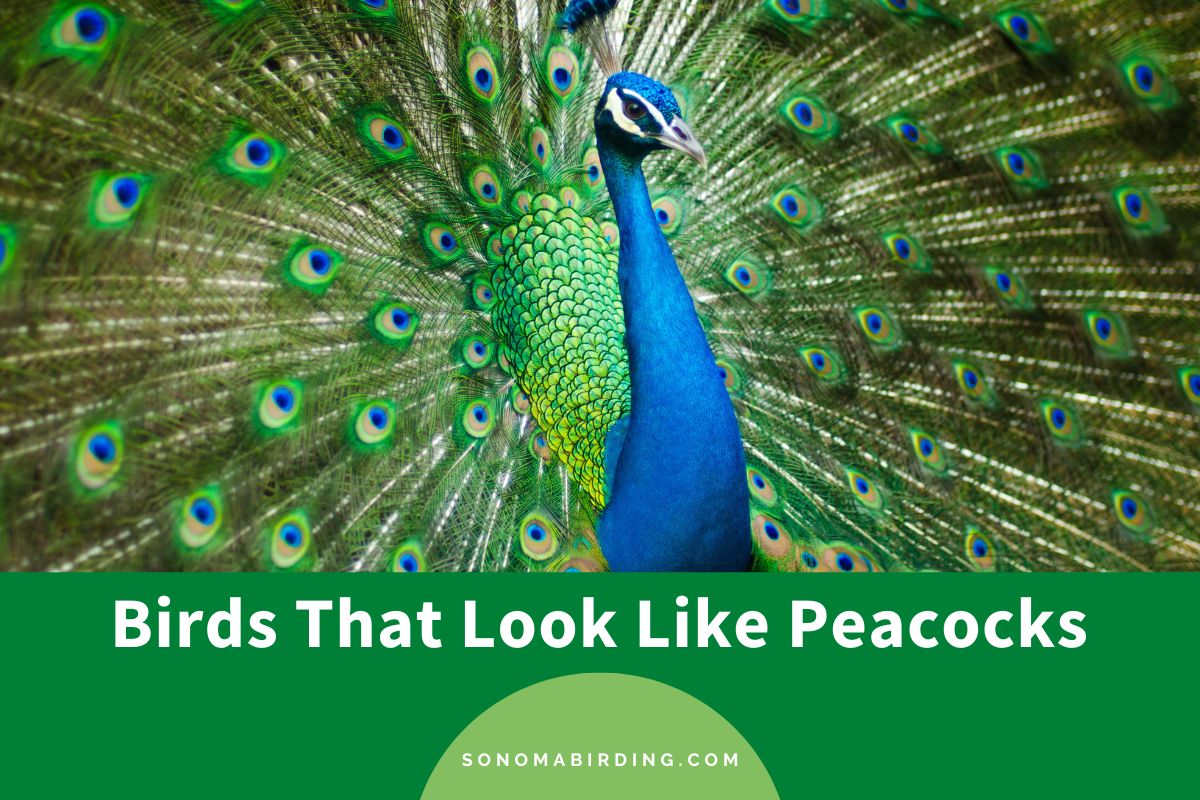Peacocks are some of the most stunning and vibrant animals that exist in the natural world. However, did you know that other birds often share many similarities with peacocks?
From appearances to habits, several birds resemble peacocks due to reasons being genetically related to convergent evolution. Not only do they exist, but there are quite a number of them, all of which we’ll discuss in this article.
1. Green Peafowl
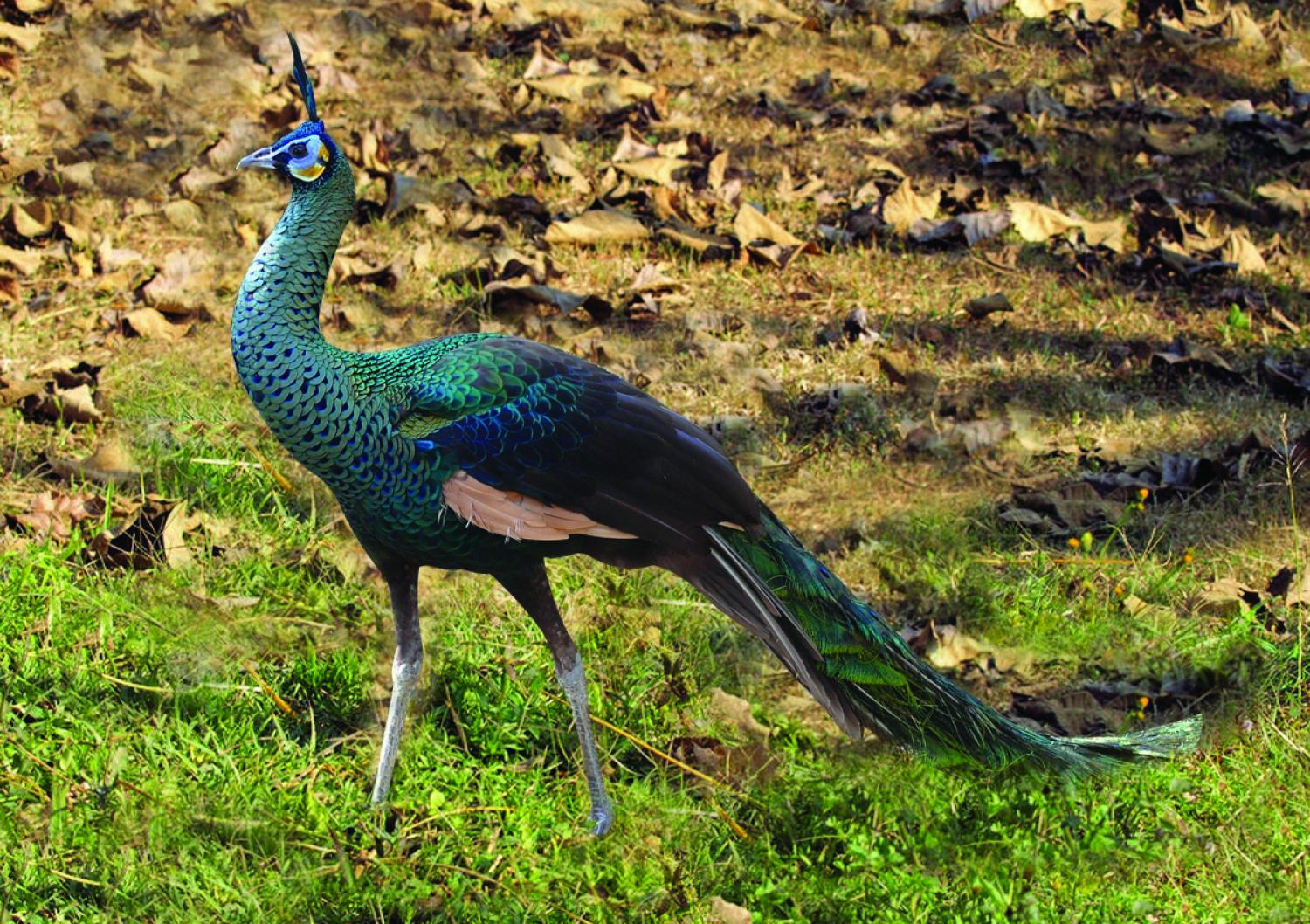
Scientific Name: Pavo muticus
Range: Southeast Asia (Myanmar, Thailand, Vietnam, Indonesia, Malaysia)
The green peafowl is a large game bird that consists of a bright green neck, dark wings, and a dark green crest that is always raised vertically. The males have the great train that is typical of peacocks, which is opened during courtship, while the females have a short tail with no ruffled plumes.
Their preferred habitats are open tropical forests near bodies of water. They are omnivores, with their diet consisting of fruits, invertebrates, reptiles, frogs, and rodents.
Like the traditional peacock, the green peafowl also has a brightly colored tail that they use to court females, as well as fan-shaped crests on their heads. Also, similar to the peacock, the female green peafowl doesn’t have the long train of tail feathers.
The biggest difference between the green peafowl and the peacock is the coloration of their plumage, in which case both males and females have green heads and crests instead of blue.
2. Congo Peafowl
Scientific Name: Afropavo congensis
Range: Democratic Republic of the Congo
The Congo peafowl is a relatively large peafowl that, for males, has deep blue plumage with metallic green and violet tinge, and for females, has chestnut brown plumage. They have a bare red-skinned neck, grey feet, and a black tail. They prefer the lowland rainforests of the Congo River Basin, where they primarily feed on fruits and invertebrates.
Like the peacock, the male Congo peafowl has bright blue plumage on its upper body, along with wings that have a shiny emerald green sheen.
Besides the blue coloration of the plumage on the male, the congo peafowl doesn’t resemble the peacock in that they are overall more pheasant-like in appearance and don’t have such a wide display of colors.
3. Black Shouldered Peafowl
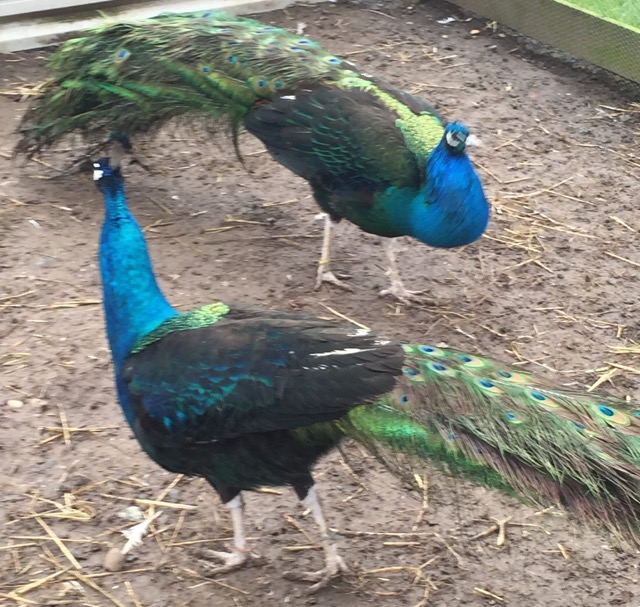
Scientific Name: Pavo cristatus
Range: Throughout Europe (mainly concentrated in the UK)
The black-shouldered peafowl is a type of Indian peafowl (the common peacock) with a pattern mutation that results in them having plain black wings with a green/blue sheen instead of the usual bright blue wings of the peacock. They are commonly raised in gardens, grassland, or farms. Their diet consists of seeds, grains, plants, insects, berries, and small reptiles.
Physically, the black-shouldered peafowl body is nearly identical to the common peacock due to it merely being a common peacock with a recessive gene mutation.
The only difference between the black-shouldered peafowl and the common peacock is the different coloration of the wings. Where the peacock has barred buff and black feathers, the black-shouldered peafowl has black features with a blue and green shine. The females, in particular, differentiate due to their cream-colored plumage, which can vary between a darker cream and brown coloration to a light cream depending on the individual.
4. Spalding Peafowl
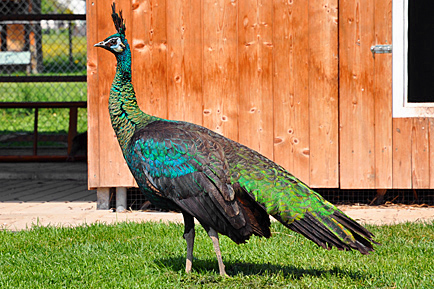
Scientific Name: Pavo cristatus
Range: In captivity
The Spalding peafowl is a hybrid peafowl that is the result of crossing the Indian and Java peafowls. They have a thin, long body shape, and green plumage around the neck and head. They are typically found at zoos, farms, or any other sheltered area or coop. They are omnivores.
Overall, the body shape of the Spalding peafowl is very similar to that of the common peacock as it is a hybrid variation of the peacock.
The Spalding peafowl has a thinner but larger body and slightly longer legs than the peacock. They are also more brightly colored and have a much more defined metallic green color on their neck and head. There’s barely any blue coloration to be found in this species. Their tail features are not as long as those of the peacock.
5. White Peafowl
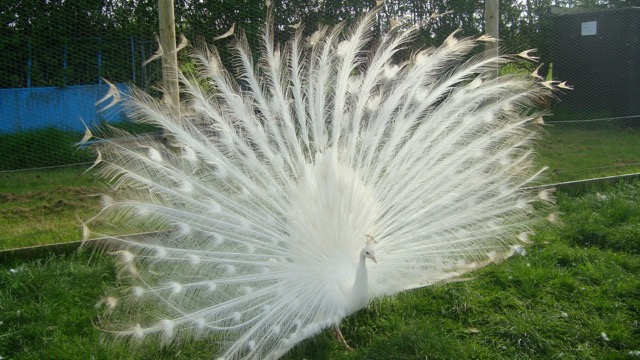
Scientific Name: Pavo cristatus
Range: In captivity
The white peafowl, similar to the Spalding peafowl, is a hybrid peafowl resulting from the crossbreeding of another white peafowl and a common peacock.
The first white peafowl most likely was born in captivity due to a genetic mutation called leucism, which prevents pigment from staying in the feathers. It is shaped just like the peacock, except its feathers are all white. They are omnivores and are found only in captivity.
The white peafowl has an identical body shape compared to that of the peacock. They have the same train of feathers that they fan out to impress the female. Their eyes and skin are also the same colors as that of the peacock.
The only real difference between the white peafowl and the peacock is the fact that all its feathers are white. Because their white feathers are a result of leucism, white peafowls are not considered albinos.
6. Impeyan Pheasant

Scientific Name: Lophophorus impejanus
Range: Afghanistan, Pakistan, Nepal, India, Bhutan, southern Tibet
The Impeyan pheasant is a large bird that consists of a coppery neck and back feathers along with a prominent white rump that is visible when it’s in flight and, for males, consists of a long, reflective green crest. The Impeyan pheasant is native to the high Himalayan scrublands and forests. Its diet consists primarily of invertebrates, roots, and tubers.
From its mainly blue plumaged body to its long tail, the male Impeyan pheasant has properties that resemble both the male and female peacock. Overall, its body shape and female coloration make the females look very similar to the female peacock.
Unlike the male peacock, the Impeyan pheasant lacks its large train and has a section of red plumage by its nape (compared to the peacock, which is completely blue). The males resemble a female peacock with male coloration.
7. Long-Tailed Widowbird
Scientific Name: Euplectes progne
Range: South Africa and Botswana
The long-tailed widowbird is a large, dark widowbird that consists of a massive tail and Red and White highlights on the wings for breeding males, streaky and brown plumage with the highlights for non-breeding males, and brown and streaky plumage for the females. Their preferred habitats include moist grassland and the occasional cultivation and open areas. Their primary diet consists of seeds, with the occasional supplement of arthropods.
The long-tailed widowbird (especially the breeding males) can be mistaken for the peacock due to its very long tail that consists of twelve feathers. The non-breeding males and females also have plumage of a very similar appearance to that of the female peacock.
The biggest differences between this species and the peacock are that the breeding males are almost completely covered in black plumage (except their shoulders and bills) and that they are much smaller than the peacock. Even though the females and nonbreeding males resemble the female peacock due to their plumage color, they are still much smaller than the female peacocks, making them easily distinguishable.
8. Lady Amherst’s Pheasant
Scientific Name: Chrysolophus amherstiae
Range: China
The lady Amherst’s pheasant is a beautiful terrestrial bird that, for males, consists of a long-striped tail, white belly, and black-and-white scaling on the neck, and, for females, brown plumage with black striping and gray skin around the eyes. Their habitat is primarily forest that contains thick undergrowth. They eat a variety of berries, shoots, leaves, grains, and small invertebrates.
The long extravagant tails of the males are highly reminiscent of the trains on peacocks. The males’ blue coloration also resembles the peacock’s blue plumage.
The lady Amherst’s pheasant isn’t as large as the peacock, nor is its entire body blue in color. Instead, the males have a variety of coloration that results in only a patch of dark navy-blue plumage above the tail.
9. Long-Tailed Paradise Whydah
Scientific Name: Vidua paradisaea
Range: Southeastern Africa
The long-tailed paradise whydah is a passerine bird that, for breeding males, consists of chestnut and black plumage and a 21-centimeter tail that is typically flattened laterally with short bulging feathers and long tapering feathers.
The females and non-breeding males have black-and-white heads, a dark bill, and a double “C” pattern under the ears. They are found throughout sub-Saharan Africa, where they feed on seeds that have ripened and fallen on the ground.
With its extremely long tail, the long-tailed paradise whydah is of a similar size to the peacock. Their long tail feathers also resemble the trains of the peacock from a distance.
The long-tailed paradise whydah lacks the brilliant blue coloration of the peacock and cannot fan out its tail feathers like a peacock.
10. Superb Lyrebird
Scientific Name: Menura novaehollandiae
Range: Southeastern Australia
The superb lyrebird is a large terrestrial bird that consists of gray-brown plumage, reddish outer wings, powerful legs, and a long tail. The “lyre” feathers have barring, while the other feathers are plain, thin, and wispy. The superb lyrebird prefers moist forests and woodlands, where they can be found feeding on seeds, insects, spiders, worms, frogs, and smaller invertebrates.
The main similarity between the superb lyrebird and the peacock is the appearance of the tail feathers. The long wispy tail feathers of the superb lyrebird, in particular, resemble the tail feathers of the peacock. The length of the tail feathers also makes the superb lyrebird appear of similar size to the peacock.
The superb lyrebird has a brown plumage compared to the bright blue seen on peacocks. They are also unable to fan out their tail feathers like the peacock.
11. Wilson’s Bird-of-Paradise

Scientific Name: Cicinnurus respublica
Range: Waigeo and Batanta Islands (Indonesia)
The Wilson’s bird-of-paradise is a small bird that consists of dark blue feet and a pale blue crown with black streaks. The males, in particular, have a bottle green chest, a red back, a yellow nape, and curly, blue tail feathers. The females are brown above and barred below. Their habitat consists of foothill forests, where they feed on fruit and small insects.
The red and yellow feathers of the male resemble the train of the male peacock. Its blue head might also appear similar to the male peacock’s head. The female has a plumage coloration that very closely resembles that of the female peacock.
The Wilson’s bird-of-paradise is much smaller than the peacock both in length and weight. The curly tail feathers on the male are also a dead giveaway.
12. Resplendent Quetzal
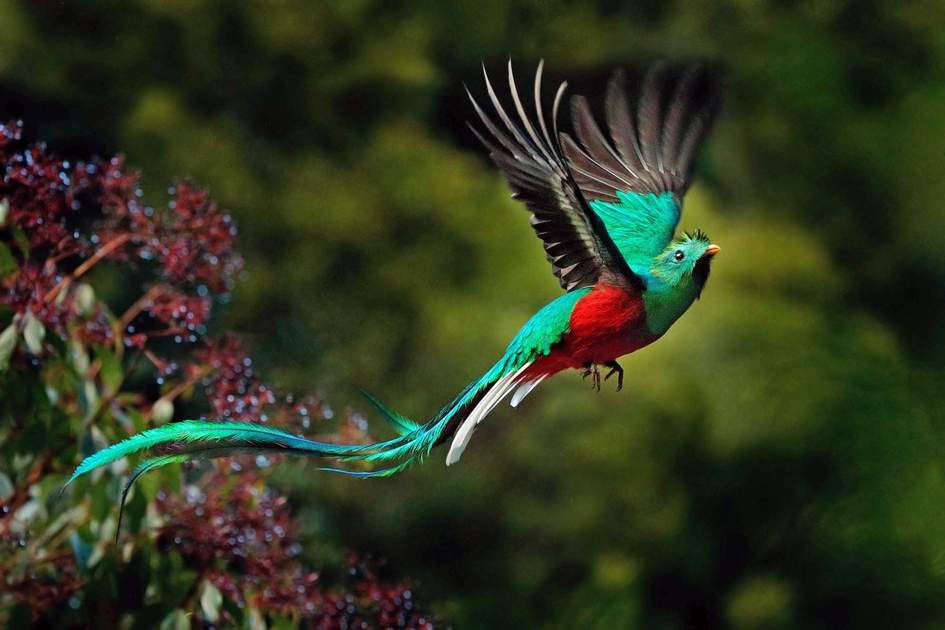
Scientific Name: Pharomachrus mocinno
Range: Southern Mexico and Central America
The resplendent quetzal is a large, bright trogon that, for males, has long emerald plumes that flow from behind in flight or from the wind while perched, and for females, has a grayish head, gray bill, and much smaller, jagged plumes on the sides of the breast. They prefer the humid evergreen and pine-evergreen forests in the mountains, where they feed on fruit, insects, frogs, lizards, and snails.
The long colorful tail of the male Resplendent quetzal gives it a very similar appearance to that of the male peacock from a distance. Its iridescence also adds to the illusion.
The resplendent quetzal is much smaller and lighter than the peacock. The tails on the males, while long, are not the trains present on peacocks, and they’re unable to fan out.
13. Golden Pheasant
Scientific Name: Chrysolophus pictus
Range: Mainland China
The golden pheasant is a small pheasant that shows clear sexual dimorphism; the males consist of a golden rump, crest, and bright red body, where the “cape” is shown as a black and orange striped fan that covers nearly everything but its eyes, and the females have a barred plumage, and dull pink legs and feet. They are commonly found in mixed and conifer woodland, where they feed on seeds, grains, berries, invertebrates, and other vegetation.
Similar to the peacock, the male golden pheasant has a very long tail that drags behind. Its overall standing appearance is also very similar to that of the male peacock.
Unlike the male peacock, the male golden pheasant can’t fan out its tail. Its bright orange and red colors also starkly contrast the deep blue plumage of the male peacock. The female golden pheasants are also of brighter color and have longer tail than their peacock counterparts.
14. Turquoise-Browed Motmot
Scientific Name: Eumomota superciliosa
Range: Central America (Guatemala, Nicaragua, Costa Rica)
The turquoise-browed motmot is a brightly colored motmot that has a medium-sized gray-blue body, a distinctive plumage, a turquoise brow, wings, and a tail with big rackets. Their habitat consists of tropical lowlands, dry areas, dry forest edges, semi-open areas with trees, and gardens. They feed on insects, arachnids, and small lizards.
The long tail of the turquoise-browed motmot, which drags along on the ground, can make it difficult to distinguish them from male peacocks.
The turquoise-browed motmot is much smaller than the peacock, male and female. Their body, though it has a blue tinge to it, is mostly gray, as opposed to the bright blue plumage of the male peacock. It also lacks the long, thin neck and legs of the male and female peacocks.
15. Ribbon-Tailed Astrapia
Scientific Name: Astrapia mayeri
Range: Papua New Guinea
The Ribbon-tailed Astrapia is a long-tailed bird that, for males, has an iridescent green head and bib with a black chest band bordered by a golden stripe, and for females, has blackish plumage with barring on the belly and slight iridescence on the head. Both have very long tails, though it’s white for males and black for females. Their habitat is the upper montane forests, where they feed on fruit, insects, arachnids, and frogs.
The extremely long tail of the Ribbon-tailed Astrapia can give it a close resemblance to the male peacock train, especially on the ground. Its iridescent plumage also makes it difficult to distinguish when a light is shone on it.
The Ribbon-tailed Astrapia is much smaller than the male peacock, with it only being around 30 cm long (without the tail) while the peacock is roughly 100 cm. Their nearly all-black body and white tail make the male species easily distinguishable from the male peacock under indirect lighting.
16. Greater Bird-of-Paradise
Scientific Name: Paradisaea apoda
Range: Papua New Guinea
The greater bird-of-paradise is a large bird that consists of a black breast and white and yellow plumes, which the male raises during his courting. The females have an all-brown body. They inhabit lowlands and the foothill forests and forest edges, where they feed on fruit, seeds, and small insects.
The white and yellow plumes of this bird, when raised, give the appearance of the fanning of the train on male peacocks. On the ground, they may resemble the male peacock with its long train as well.
The greater bird-of-paradise is roughly half the size of the peacock. The male’s coloration, which is black, white, and yellow, also makes it easy to distinguish them from the peacocks, which have a blue plumage with a spotted train.
17. Great Crested Grebe
Scientific Name: Podiceps cristatus
Range: Europe, Middle East, and Asia
The great crested grebe is a large grebe that consists of tawny cheeks and flat, black crests for breeding birds and a bright white face and neck with a dark line through the eye for non-breeding birds. Their habitats include lakes, reservoirs, rivers, and inshore ocean waters. They prey mainly on fish, crustaceans, insects, frogs, and newts.
The great crested grebe has a long neck and head shape that makes it closely resemble that of the peacock from a distance away. They also resemble the female peacock due to their brown and streaky plumage.
The great crested grebe is smaller than a peacock, and the male’s coloration is browner and streakier than the pure blue plumage of the male peacock. They lack the long train of the male peacock as well. Finally, they have lobs that enable them to be excellent swimmers and divers, something the peacocks’ lack.
18. Red-billed Streamertail
Scientific Name: Trochilus polytmus
Range: Jamaica
The red-billed streamertail is a glittering bird with very long outer tail feathers (males only) and a red bill. The immature males are mostly green with a black cap, similar to the males but without long tail feathers. The females are green above and dingy below. Their habitat consists of moist woodlands, gardens, and parks, where they feed on nectar from flowers and small insects.
The male red-billed streamertail resembles the male peacock through its extremely long tail, which looks similar to the peacock’s train. The females have a plumage of a similar color to that of the female peacock.
The red-billed streamertail is much smaller than the peacock (about ten times shorter). They also lack the long neck and legs of the peacock. The plumage on the male is a darker, greener color compared to the bright blue plumage on the male peacock. Finally, they have a much longer, narrower bill than that of the peacock.
19. Greater Racket-tailed Drongo

Scientific Name: Dicrurus paradiseus
Range: Southeast Asia, Nepal, India
The greater racket-tailed drongo is a large drongo with black plumage, a notched tail, long, racket-like outer tail streamers, a glossy neck, and a backward curving crest. Their habitat includes woodlands and forests. Their diet consists mainly of insects, as well as the occasional fruit and nectar.
The outer tail streamers are very reminiscent of the train on the male peacocks, both while perched and during flight. Their glossy plumage also resembles the iridescent plumage of the peacock.
Their all-black plumage distinguishes the greater racket-tailed drongo from both sexes of the peacock. They’re also much smaller and lack the train of the male peacock.
20. Yellow-bellied Greenbul
Scientific Name: Chlorocichla flaviventris
Range: Southern Africa
The yellow-bellied greenbul is large greenbul with green upperparts and yellow underparts with a red-brown eye and broken white eye ring. They also have a small shaggy crest and yellow underwings that differentiate them from other greenbul species. Their habitat includes thickets and forest edges, where they feed on fruits and insects.
The yellow-bellied greenbul has a rather long tail that can resemble the tail of the female peacock. The plumage on their upper parts also resembles the plumage of the female peacock.
The yellow-bellied greenbul is much smaller than the peacock. They lack a long neck and legs and have a yellow underpart, while the female peacock has a pale underpart.
21. Common Kingfisher
Scientific Name: Alcedo atthis
Range: Europe, Middle East, Asia, Southeast Asia
The common kingfisher is a small bird with blue and orange plumage and a long pointed bill. Their natural habitats include areas alongside rivers, streams, lakes, ponds, and any other fresh or brackish habitat with small fish. They eat mainly fish, with the occasional aquatic insects, shrimps, and tadpoles.
The main similarity between the common kingfisher and the peacock is its blue upperpart plumage. Its color is very similar to the blue plumage of the male peacock.
The common kingfisher is smaller than the peacock and lacks its characteristic neck. It also has a much longer, prominent bill, and orange underparts, something completely absent in the peacock. It also has a relatively short tail.
22. Marvelous Spatuletail
Scientific Name: Loddigesia mirabilis
Range: Peru
The Marvelous Spatuletail is a beautiful hummingbird that, for males, consists of a very long tail with two rackets, a blue crown, and iridescent green throat, and for females, a green upperpart and white underpart. They are strictly restricted to the Andean cloud forest in northern Peru, where they prefer staying at forest edges or in clearings. As hummingbirds, they feed primarily on nectar.
The long tail of the male Marvelous spatuletail (when perched together) resembles the train of the male peacock. The female plumage is also similar to the plumage found on female peacocks.
As a hummingbird, the marvelous spatuletail is minuscule compared to the peacock. It also has the characteristic long and narrow bill of the hummingbird, something that is lacking in the peacock. Though iridescent in their own right, the peacocks lack the green throat on the marvelous spatuletail that can change color depending on the angle of the light.
23. Crested Caracara

Scientific Name: Caracara plancus
Range: Southern US, Central, and South America
The crested caracara is a large raptor that consists of a dark cap, pale neck, dark body, and a face that can vary from orange-red to pale pink. Its habitat includes open areas such as grasslands with scattered trees, open fields, deserts, and beaches. They feed primarily on lizards and snakes.
The crested caracara has rather long legs reminiscent of the legs of the peacock. The juveniles, in particular, have plumage similar to the plumage found on female peacocks.
The crested caracara lacks the blue plumage found on male peacocks, the long necks found on both peacock sexes, and the train of the male peacock.

